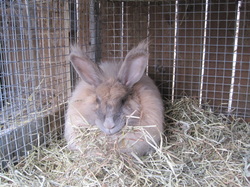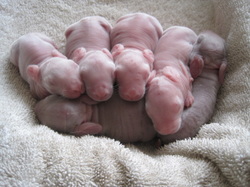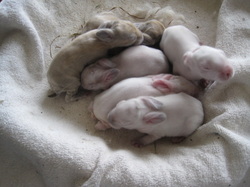Spring has arrived at Two Oaks Farm - although some days you would scarcely know it! It's been downright cold on several recent days, and we have been having night time temperatures in the 20's. We DO have the first of the spring litters arriving, though, and the moms are working overtime to pull more fur to keep the babies snug and warm.
Among the things I enjoy most about raising French Angora rabbits is the variety that each new litter brings. While there are quite a few generalizations that can be made about how does behave before, during and after their babies are born, I have found that each one of my does has her own take on how all of this should be done. And I enjoy the variety of colors, and trying to identify each color in the nest box as the babies mature.
One thing that always makes me smile is the sight of a doe carrying hay in preparation for making a nest. They always seem so bemused, as though they just can't quite understand it, but they are absolutely compelled to carry hay and make a nest - and then they just must pull fur....! Not only do the girls look funny to me, but I also smile because this behavior is an almost certain sign that they are indeed pregnant - almost certain...! I have two new litters in the nestbox, and each of these does took a different approach to her nestbuilding, yet each wound up with a healthy litter, born in the nestbox. The first doe, Frosty, went through a fairly early phase of active hay-carrying and nest building, but then just stopped. I looked and looked for more "signs", but had all but given up on this expected litter when - surprise! - right on time, day 31, I discovered a lovely little litter of 4 snuggled up together in her nest box. At the last moment she must have gotten that nest done, and while it was not the most spectacular of nests, it sufficed! Over the next few days she co ntinued to pull more fur, most likely in response to the unexpectedly cold temperatures during that time (spring litters with sub-freezing temps???), so I had to keep checking and snipping the new strands into pieces 1/2 " long or less to prevent any babies from becoming entangled.
Among the things I enjoy most about raising French Angora rabbits is the variety that each new litter brings. While there are quite a few generalizations that can be made about how does behave before, during and after their babies are born, I have found that each one of my does has her own take on how all of this should be done. And I enjoy the variety of colors, and trying to identify each color in the nest box as the babies mature.
One thing that always makes me smile is the sight of a doe carrying hay in preparation for making a nest. They always seem so bemused, as though they just can't quite understand it, but they are absolutely compelled to carry hay and make a nest - and then they just must pull fur....! Not only do the girls look funny to me, but I also smile because this behavior is an almost certain sign that they are indeed pregnant - almost certain...! I have two new litters in the nestbox, and each of these does took a different approach to her nestbuilding, yet each wound up with a healthy litter, born in the nestbox. The first doe, Frosty, went through a fairly early phase of active hay-carrying and nest building, but then just stopped. I looked and looked for more "signs", but had all but given up on this expected litter when - surprise! - right on time, day 31, I discovered a lovely little litter of 4 snuggled up together in her nest box. At the last moment she must have gotten that nest done, and while it was not the most spectacular of nests, it sufficed! Over the next few days she co ntinued to pull more fur, most likely in response to the unexpectedly cold temperatures during that time (spring litters with sub-freezing temps???), so I had to keep checking and snipping the new strands into pieces 1/2 " long or less to prevent any babies from becoming entangled.

'Blue' carried hay on a near-constant basis!
Doe number 2, "Blue" (a blue tort), was simply overtaken by the need to nest, and spent nearly two weeks before her due date moving hay on a near-constant basis. She built a picture-perfect nest, with a perfect little circular space in the hay near the back of the next box, and an abundance of hay and fur - quite the architect! And then she surprised me by not delivering on her due date (I couldn't believe that there was no litter, with all that nest-building activity!), but instead kindling a couple of days later. Blue wins the prize for providing the most abundantly fur-lined nest of any of my does so far; the poor dear plucked herself nearly naked in a couple of spots! My daughter had the fun of discovering this litter buried under all that fur. She was checking on Blue while I was away, was about to go, then turned back to look again because something seemed slightly different - then she notice the fur move slightly, and discovered 6 brand new little pink babies!

2 Pearls and 2 REW rest on the 2 Blue Torts
Even more entertaining than the variety of behaviors my does display is the variety of colors that pop up in litters, and antcipation of what colors each litter will contain. Knowing the genetics of both of the parents, there is a limited set of colors that might show up in the next box, and you can have a pretty good idea of what colors are most likely, but unless you are breeding REW to REW, there is always the chance that some rare or unexpected color might pop up. Each litter is like a surprise package!

The tort color is more developed, the pearls are showing up.
My first recent litter was pretty straightforward and easy to identify from day one: 3 REW's and 1 black. But litter number 2 took a while to reveal its true colors; all were pink at birth, with scarcely a hint of what they might become. Some colors are obvious in the nest box - black and chestnut, for example. But many colors are not so readily identified until the babies' fur begins to grow in over the first few days. I know some breeders who have a really keen eye for color, and can generally identify colors on day one, but that's not me! By day 3 or 4 I was sure I had a couple of torts, and from their coloring they appeared to be the blue torts I was hoping for in this litter. It took a few more days for it to become clear that another pair were pearls, and right now it looks like one of these could be a blue pearl, which would be something different for me. The final two in this litter have remained pink, and so are REW's.
I keep my litter boxes and newborn litters inside for the first 2 to 3 weeks, depending on weather and other factors, taking the boxes to the mothers to nurse once or twice each day. Again, the does differ on when and how often they prefer to nurse, and also in how sensitive they are to my presence. I start by bringing the box to the mom in the morning and the evening, and some does readily jump in to nurse each time, but I often soon discover that other does will only nurse in the morning, others in the evening, so I bring the nest boxes out to suit each doe's preference. I also find that, while some does are completely oblivious to my presence, jumping right in to nurse, others are quite shy and hesitate, waiting to nurse until I am out of sight. I adjust my actions to the nursing does.
It took me a while to adjust to the way that rabbits mother their young. Having in the past raised dogs and had litters of kittens, I was accustomed to the mothering instincts of these species, which seem to make sense to us humans, as they are more like ours. Dogs and cats appear more nurturing than do rabbits, providing near constant attention, vigilance, frequent nursing, and even affection for their offspring. Rabbits, on the other hand, can be perplexing. They nurse once or perhaps twice a day, and other than that they seem to completely ignore their young. They hop into the nest, nurse for just a few short minutes, then hop out and seem to not care in the least for those precious babies! It is easy to conclude that your does are terrible mothers, but you would be mistaken. To understand rabbit behavior in general, and their mothering in particular, you have to constantly keep in mind their position in the food chain. Unlike dogs and cats, rabbits are prey animals, and that makes a big difference! The best, most "loving" thing they can do for their young is to ignore them as much as possible! By staying away from her nest of vulnerable babies, the mother rabbit is protecting them, minimizing their chances of them being detected by any number of predators that would just love to make a meal out of them. It's very useful to keep that perspective in interpreting and even predicting your rabbit's behavior.
It took me a while to adjust to the way that rabbits mother their young. Having in the past raised dogs and had litters of kittens, I was accustomed to the mothering instincts of these species, which seem to make sense to us humans, as they are more like ours. Dogs and cats appear more nurturing than do rabbits, providing near constant attention, vigilance, frequent nursing, and even affection for their offspring. Rabbits, on the other hand, can be perplexing. They nurse once or perhaps twice a day, and other than that they seem to completely ignore their young. They hop into the nest, nurse for just a few short minutes, then hop out and seem to not care in the least for those precious babies! It is easy to conclude that your does are terrible mothers, but you would be mistaken. To understand rabbit behavior in general, and their mothering in particular, you have to constantly keep in mind their position in the food chain. Unlike dogs and cats, rabbits are prey animals, and that makes a big difference! The best, most "loving" thing they can do for their young is to ignore them as much as possible! By staying away from her nest of vulnerable babies, the mother rabbit is protecting them, minimizing their chances of them being detected by any number of predators that would just love to make a meal out of them. It's very useful to keep that perspective in interpreting and even predicting your rabbit's behavior.
 RSS Feed
RSS Feed